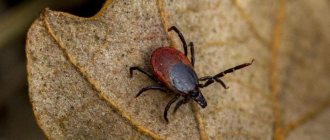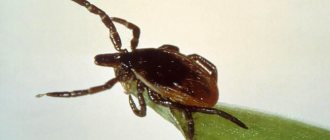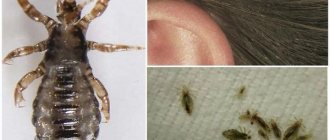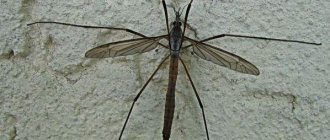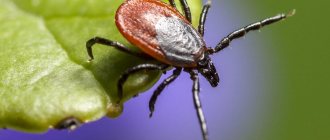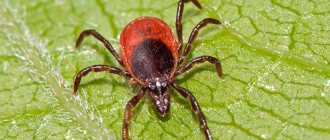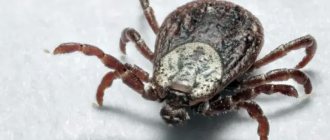The taiga tick is a common representative of ixodid ticks. This is a highly specialized parasite that feeds on the blood of its victims - all kinds of animals and humans.
Tick at gunpoint
The official literature contains information about the name of the taiga tick – Ixodes persulcatus.
Arthropods are ubiquitous and can live on shrubs, tall grass vegetation, and thickets.
They wait for a long time for their prey, which they can smell from a great distance. The bite of a taiga tick is dangerous for humans, as the parasite can carry serious diseases.
Features of the taiga tick
The taxonomy of the taiga tick is as follows:
- kingdom - animals;
- section – bilateral, bilaterally symmetrical;
- phylum – arthropods;
- class – arachnids;
- superorder – parasitiform mites;
- order – ixodid ticks;
- species - taiga tick.
The tick's food source is the blood of all warm-blooded animals, domestic or wild, and humans. Larvae and nymphs of taiga ticks attack small rodents, mice, squirrels, birds or hares.
Tick on an animal
Mature individuals pose a danger to humans; nymphs rarely bite people. The eyes of the arachnid are not developed; they capture potential prey using thermoreceptors.
The smell of an animal or person is felt at a distance of about twenty meters, moving in the right direction. From a distance of half a meter, the arthropod distinguishes the body heat of the prey.
Parasites concentrate near roads and forest paths. Sitting on tall grass or tree branches, ticks cling to the body of the victim with the help of two front legs. By pulling them forward, when the opportunity arises, they catch on the clothing or fur of the animal.
Taiga tick bite
Then they look for the most suitable place on the victim’s body and stick to the skin. While hunting, ticks sit in vegetation at a height of no more than a meter from the ground.
They attack small animals by falling from above. When approaching a person or large animal, the parasites attach themselves to the legs, moving up the body in search of thin skin. Most often they bite through the skin in the groin, neck, abdomen or armpits.
Appearance
The taiga tick is small in size, which is why it is so difficult to detect in the grass or on the body. An adult hungry female has a flat, rounded body. Its length is about 4 mm, rarely reaching 6 mm.
Dimensions of the taiga tick
Having drunk blood, the parasite increases significantly in size.
The structure of the taiga tick makes it look like a small spider - a body with 8 dark legs located on the sides.
Tick structure
On the wedge-shaped head there is a proboscis with sharp jaws. It is with their help that the parasite makes a hole in the victim’s skin.
Males and females are distinguished by certain differences - structure and color. The male tick has a chitinous cover, colored black.
Male and female tick
The female individual has a similar shell, but in her it occupies only a third of the entire body. The rest of the body consists of folds of skin that stretch when the abdomen fills with blood.
The female's body increases 5-8 times. Color black-red or brown-red.
Adult female tick
Their size is much larger than that of males, whose maximum length is 2.8 mm.
Habitat and food
Initially, the tick's habitat was in the taiga part of Siberia. Over the past hundred years, the arachnid's habitat has expanded significantly for a number of reasons, including significant climate warming.
Towards the west, the parasite's distribution border includes the Baltic states, Belarus, and the southeastern part of Finland. In the north, the territory ends near Petrozavodsk, in the south – in the Ulyanovsk and Samara regions.
The eastern border ends at the Pacific Ocean. The taiga parasite is found in Japan, in the east and north of China, on Sakhalin, the Kuril Islands and Kamchatka. There are isolated islands of tick-infested areas in the mountain ranges of Central Asia.
Life and reproduction
The life cycle of the taiga tick includes two main aspects - reproduction and the search for a source of blood.
During the hunting season, arachnids are located in the grass, on bushes or on the lower branches of trees, waiting for potential prey. The parasite does not rise above a meter.
Path in the forest
At this time, ticks move towards paths and roads, and less often remain in dense bushes or meadows. Prefer moist, dark places.
Ticks live in wild places, and they can be found in city parks, cemeteries, and summer cottages. They can get here with the help of birds, rodents, animals or humans. It is a mistake to think that you can only be afraid of a bite in the forest.
Mating begins in the spring. The process can occur in the environment or at the moment when the female, having sucked, drinks blood. A fed and fertilized female lays from 1.5 to 2.5 thousand eggs.
Ixodid tick egg laying
After two to three weeks, larvae emerge from the eggs, 0.5 mm long and with six legs.
While developing, the larvae drink the blood of rodents or birds for several days. Upon returning to the forest, they molt, moving to a new stage of maturation - they become nymphs. Nymphs already have eight legs and reach a length of up to 1.5 mm.
Life cycle of a tick
At this stage of development, the tick overwinters, after which it begins to hunt larger representatives of warm-blooded animals and humans, including. After another moult, the nymphs turn into adult ticks by the following spring.
You can also read our article: How long does a tick live, which affects the life expectancy of the parasite
Why is the taiga tick dangerous?
The bite of a blood-sucking parasite is not dangerous - the affected area turns red, swells, and a point of dried blood appears in the center.
Such traces are left behind by a larva, nymph or male. Once they get drunk, they disappear on their own.
The female, having sucked, goes deeper into the body of the victim. It penetrates deep until the entire head is under the skin.
Tick embedded in skin
You need to pull the parasite out of the wound with skillful movements, otherwise its head will remain in the body.
The part of the tick that is torn off and remains under the skin can cause an inflammatory process and suppuration will begin. This is just one example of how dangerous the taiga tick is.
The process of removing a tick by a doctor
To remove it correctly, it is better to contact a medical facility.
How to detect a tick on the body
The parasite can be detected by carefully examining the body after visiting a forest or cottage.
Inspecting the body for ticks
It is advisable to remove outer clothing in front of the door and shake it out thoroughly.
After a walk in the city park, your pet can bring it home. It is imperative to inspect the fur and body of the animal to identify arthropods.
Symptoms of diseases
It is a known fact that taiga ticks are carriers of encephalitis.
Today, five types of the disease are known:
- febrile form of encephalitis - high temperature, lethargy, headache, nausea, sleep disturbance;
- meningeal form of encephalitis - serious complications in the form of hydrocephalus and epileptic seizures;
- polyradiculoneuritic form of encephalitis - the brain and nervous system are affected, sensitivity of the limbs disappears;
- meningoencephalitic form - vomiting, hallucinations, impaired consciousness, often ends in irreversible changes in the brain.
How to protect yourself
It is important to choose the right clothes when going for a walk in the forest. It should be light, made of dense fabric.
Line of anti-tick suits BIOSTOP
The sleeves are long, with cuffs, and the bottom of the trouser legs is tucked into the shoes. It is better to avoid overgrown paths in the forest.
Residents of regions where there is a high risk of contracting encephalitis are recommended to get vaccinated.
Using chemicals and listening to the advice of experts, you can protect yourself from tick bites.
If you find an attached parasite on your body, it is better to seek medical help.
Taiga tick (Ixodes persulcatus)
The taiga tick is found in coniferous, deciduous and mixed forests, mainly in Siberia and the Far East, in the northeastern and central regions of the European part of Russia.
The female has an oval or ovoid body up to 3 mm long. There is a long proboscis at the anterior end of the body. Four-segmented palps are attached to the base of the proboscis, covering the proboscis from above. With their help, the place for suction is determined. The genital opening is located in the middle part of the abdomen, the anus is closer to the posterior end of the body. An arched groove is clearly visible, going around the anus in front.
The taiga tick parasitizes many mammals and birds, maintaining the circulation of the taiga encephalitis virus among them. The main natural reservoir of the encephalitis virus is chipmunks; Hedgehogs, voles and other mammals and birds perform the same role. Larvae and nymphs feed on small wild animals and birds. Each stage takes at least a year to develop. Adult ticks are active from April to July and usually parasitize domestic and wild ungulates. Life expectancy is up to three years, and in a hungry state it is possible to remain viable for up to a year. Of all the ixodid ticks, Ixodes persulcatus is especially dangerous, as it most often attacks humans. Taiga ticks are carriers of tick-borne encephalitis viruses. Transovarial transmission of the virus is possible. Tick-borne encephalitis is a widespread natural focal infectious disease. In the Russian Federation, in recent years there has been a significant increase in the incidence of tick-borne encephalitis; the maximum number of cases was registered in 1996 (10,298 cases). Currently, the most unfavorable regions are Western Siberia (46.9% of the total number of cases in Russia), the Urals (34.5%), Eastern Siberia (6.3%) and the Far East (5.9%). The increase in the incidence of tick-borne encephalitis in Russia in recent years is explained by the general unfavorable environmental situation in the country, the cessation of acaricidal treatments, the urbanization of new territories, increased contact of the population with ticks in natural foci of tick-borne encephalitis when visiting forests (recreation, picking berries, mushrooms, tourism, etc.). d.).
Tick-borne encephalitis is a zooanthroponotic viral disease. The causative agent of the disease belongs to B-arbuviruses (small RNA viruses). The virus is not resistant to high temperatures and ultraviolet irradiation. Gastric juice of normal acidity at a temperature of 37°C almost completely inactivates the virus after 2 hours. The virus enters the human body through a tick bite or through the raw milk of domestic animals, spreads through the bloodstream and quickly penetrates the brain, where it is fixed by cells, causing degenerative changes. In parallel, inflammatory changes in the blood vessels and membranes of the brain develop.
The incubation period for tick-borne encephalitis lasts from 8 to 23 days (if infected through milk, 7-10 days). At the onset of the disease, a feverish state, headaches, nausea are observed, meningeal symptoms appear, and signs of damage to the central nervous system. Characterized by impaired coordination of movements and sensitivity, mental disorders. The acute period lasts from 3 to 14 days.
Human susceptibility to tick-borne encephalitis is universal. The disease affects people of all age groups. After suffering from tick-borne encephalitis, long-term and stable immunity is maintained; this is the basis of one of the most important preventive measures carried out by the sanitary and epidemiological services of Russia.
For the diagnosis of tick-borne encephalitis, epidemiological prerequisites are important: 1) seasonality; 2)stay in an endemic area; 3) tick suction; 4) characteristic lesions of the nervous system. Serological tests are used to confirm the diagnosis.
Recommendations for the prevention of tick-borne encephalitis. Personal prevention comes down to protection against tick bites: the use of repellents, the use of special protective clothing. Public prevention. The most appropriate is the use of acaricidal preparations for treating premises. Carrying out measures to destroy biotopes in which ticks settle. The destruction of tick host animals is important. The leading role in the prevention of tick-borne encephalitis belongs to preventive vaccinations. Specific prevention is carried out by vaccination with a liquid adsorbed vaccine against tick-borne encephalitis. It is necessary to carry out sanitary and educational work among contingents living in areas of tick-borne encephalitis.
